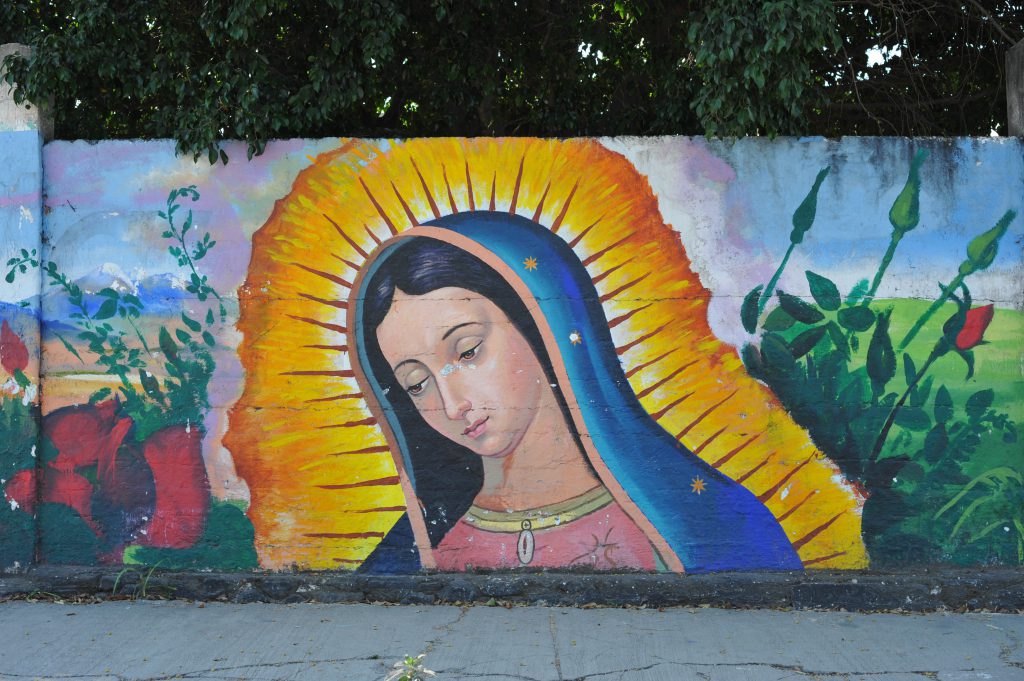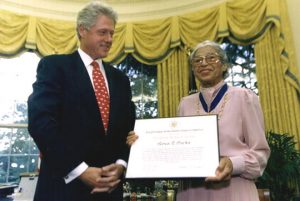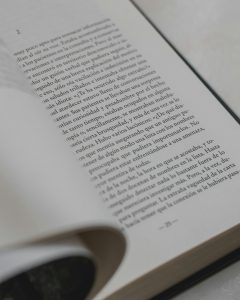Imagine waking up one day and going about your regular routine, when suddenly something happens that will not only change your life but the lives of Catholics and Mexicans forever.
At dawn on December 9, 1531, Juan Diego, who was a young Aztec Indian from the village of Cuautitlán, was on his way to attend weekly mass at the Franciscan church at Tlatelolco. He had recently converted to Catholicism, and the church was a few miles away from his uncle’s house, where he lived at after the death of his parents. While taking a shortcut over the hill of Tepeyac, he heard his name being called, and at the same time he heard music and the singing of birds.1 He followed the sounds and heard someone calling to him from the peak of the hill, “Juanito, Little Diego.” When he reached the top of the hill, he saw a young lady standing there who motioned for him to come closer: “Juanito, the smallest of my sons, where are you going?” He answered: “My Lady and my child, I have to go to your house in Mexico, Tlatelolco.” She declared herself to be “the eternal Virgin, holy Mother of the true God” and “merciful Mother” of men.2 She told Juan Diego to go to the bishop of Mexico, the Spaniard Fray Juan de Zumarraga, and tell him that she wished to have a church built on the hill of Tepeyac.3 This was the start of a life-changing moment for Juan Diego and soon, for Catholics all over the world.

Later that day, Juan Diego made his way to the bishop’s palace, which was about four miles away, and after some difficulty with the guards, he was eventually admitted to the bishop’s study, and he delivered the message from the Virgin Mary and told him everything that he admired, saw, and heard.4 The Bishop answered: “You will come again, my child, and I will think about the message you have brought.”5 Zumarraga was sympathetic but not convinced by the story that Juan Diego told him. As the first Catholic bishop of Mexico, he had heard many wild stories from converted Indians, and needed more time to think about it. In the recent decade, the colony of New Spain had been established after Hernan Cortes conquered the Aztecs in 1521. One of the goals of the Spanish was to convert the native indigenous population to Christianity. However, this was a very slow process. In many areas, the old religious practices were still being maintained a decade later. Some of the beliefs of the natives were incorporated into their own form of Christianity.6 Juan Diego left the bishop’s palace feeling very sad and returned to the hill where he had previously seen the Virgin, and explained to her what happened with the bishop, and suggested that it would be a better idea for her to send someone more important than he was to the bishop. The Virgin reassured him that he was the chosen one, and directed him to visit the bishop again the following day.7
The next day, on December 10, Juan Diego returned to the bishop’s palace and asked him if they could build the church for the Virgin Mary. The bishop asked him many questions in order to test his truthfulness, such as where he had seen her and how she looked, and Juan Diego answered everything precisely to the bishop.8 The bishop listened carefully but said he would need some proof before building a church for her. He directed Juan Diego to bring back an unmistakable sign for the validation of the apparitions that occurred. After Juan Diego left, the bishop then sent two of his staff to follow him and report back what they had seen. Juan Diego went back to the hill at Tepeyac and the staffers that were following him lost sight of him and returned back to the bishop’s palace. Meanwhile, Juan Diego had seen the Virgin Mary again, and told her the answer that the bishop had given him. She told him to come back the following day and she would give him a sign for the bishop.9
When he returned home, Juan Diego found his uncle, Juan Bernardino, seriously ill and at the point of dying. He nursed him all through the night. In the morning, he decided to call on a priest from the church at Tlatelolco to administer the last rites, as his uncle’s health was not improving. Juan Diego was worried that he had failed to meet with the Virgin Mary, and took the longer and lower road to Tlatelolco instead of the shortcut over the hill of Tepeyac. But the Virgin appeared on the lower path and told him that there was no need to worry about his uncle Bernardino, whom she had visited and was now cured. She then told Juan to go back to the top of the hill, where he would find many flowers growing. His mission was to pick a bunch of the flowers, wrap them in his cloak, and take them to the bishop. The Virgin stressed that these flowers must be concealed and not shown to anyone else.10

The top of the hill was not a place where flowers would usually grow, because of thorns, thistles, cactus, and small weeds. And it was the month of December, when everything is killed by the frost. However, he found some beautiful and fragrant roses growing, so he picked a bunch, wrapped them in his cloak, and headed down towards the Virgin to show her what he had discovered. The Virgin took them in her hands and told him that this bunch of flowers was the proof that he needed to show the bishop, and in showing him, the bishop would believe all that Juan Diego had said.11 He picked up the bunch of flowers, wrapped them in his cloak, and headed towards the bishop’s palace one last time, and upon arrival, the guards demanded to know what he was carrying in his cloak. The guards could smell the flowers and when they opened the cloak, the roses were fresh, fragrant, fully open, and precious. They took the cloak away from Juan and attempted to grab some of the flowers, but once they had opened it again and reached to grab some, the roses had become painted flowers on the inside of the cloak. They took Juan to the bishop and when he unfolded his white cloak to the bishop, the fresh roses spilled out onto the floor. When the various roses fell on the floor, the bishop saw that on the inside of the cloak where the flowers once had been, a portrait of the Virgin Mary appeared.12

When the bishop and all that were present saw this image, they fell to their knees in admiration. The bishop took the cloak to his chapel, where he then prayed and thanked God and the Virgin for the miracle. The bishop, astounded by this miracle, asked to be taken to where Juan Diego had seen the Virgin Mary. Upon arrival at the hill of Tepeyac, the bishop ordered that the church that the Virgin Mary had requested to be built would indeed be built, and would be named “The Basilica of Our Lady of Guadalupe,” which is located in present-day Mexico City. The cloak with the picture of Our Lady of Guadalupe can be found at this church that was built in her honor.13
It has been said that the dark-skinned image of Mother Mary as a virginal Native American girl helped the Spanish priests convert millions of Mexican Indians to Catholicism.14 Occasionally, we encounter a symbol that seems to enshrine the major hopes and aspirations of an entire society. Such a master symbol is represented by the Virgin of Guadalupe, Mexico’s patron saint. Her image was not only used during wars and battles as a figure of protection, but is also still used to adorns house fronts, churches and home altars, restaurants, and so much more. Her shrine at Tepeyac is visited each year by hundreds of thousands of pilgrims that all go to honor her.15 To the present day, Our Lady of Guadalupe remains a powerful symbol of Mexican identity and faith, and her image is associated with everything from motherhood to feminism to social justice. Her image has often graced the banners of those struggling for Mexican independence, and she has been understood by many devotees to side with oppressed and poor people. Mexican immigrants to the United States brought with them their devotion to her—privately and affectionately called “La Morenita”—and have helped to perpetuate her identification with others.16 After the apparitions of the Virgin Mary occurred, many Catholics began to honor her and see her as their own mother, especially Mexicans since they often refer to her as “nuestra Madre” or “Our Mother” and adopted her as their own. The feast of Our Lady of Guadalupe is celebrated every December 12, which became a national holiday in Mexico in 1859, and she has been recognized as the patron saint of Mexico.17

- Encyclopedia of Occultism and Parapsychology, 2001, s.v. “Guadalupe Apparitions (of the Virgin Mary)”, by J. Gordon Melton. ↵
- Samuel Marti, The Virgen of Guadalupe and Juan Diego (Ediciones Euroamericanas, 1973), 36-38. ↵
- Encyclopedia of Occultism and Parapsychology, 2001, s.v. “Guadalupe Apparitions (of the Virgin Mary)”, by J. Gordon Melton. ↵
- Encyclopedia of Occultism and Parapsychology, 2001, s.v. “Guadalupe Apparitions (of the Virgin Mary)”, by J. Gordon Melton. ↵
- Samuel Marti, The Virgen of Guadalupe and Juan Diego (Ediciones Euroamericanas, 1973), 39. ↵
- Global Events: Milestone Events Throughout History, 2014, s.v. “The Virgin of Guadalupe Appears to Juan Diego”, by Jennifer Stock. ↵
- Encyclopedia of Occultism and Parapsychology, 2001, s.v. “Guadalupe Apparitions (of the Virgin Mary)”, by J. Gordon Melton. ↵
- Samuel Marti, The Virgen of Guadalupe and Juan Diego (Ediciones Euroamericanas, 1973), 43. ↵
- Encyclopedia of Occultism and Parapsychology, 2001, s.v. “Guadalupe Apparitions (of the Virgin Mary)”, by J. Gordon Melton. ↵
- Encyclopedia of Occultism and Parapsychology, 2001, s.v. “Guadalupe Apparitions (of the Virgin Mary)”, by J. Gordon Melton. ↵
- Samuel Marti, The Virgen of Guadalupe and Juan Diego (Ediciones Euroamericanas, 1973), 48. ↵
- Encyclopedia of Occultism and Parapsychology, 2001, s.v. “Guadalupe Apparitions (of the Virgin Mary)”, by J. Gordon Melton. ↵
- Global Events: Milestone Events Throughout History, 2014, s.v. “The Virgin of Guadalupe Appears to Juan Diego”, by Jennifer Stock. ↵
- The Gale Encyclopedia of the Unusual and Unexplained, 2003, s.v. “Virgin of Guadalupe,” by Brad Steiger and Sherry Hanson Steiger. ↵
- Eric R. Wolf, “The Virgin of Guadalupe: A Mexican National Symbol,” The Journal of American Folklore 71, no. 279 (1958): 1. ↵
- Contemporary American Religion, 1999, s.v. “Virgin of Guadalupe,” by Sandra L. Zimdars-Swartz. ↵
- Contemporary American Religion, 1999, s.v. “Virgin of Guadalupe,” by Sandra L. Zimdars-Swartz. ↵



103 comments
Paula Ferradas Hiraoka
Even if I already reviewed this story in high school, everytime I read it, I always find new things that amaze me more, and this article is not the exception. The way you told the history of Juan Diego and how you described even the little details is incredible. Also, good selection of images, it helps the lector to have an idea of The Virgin of Guadalupe or Juan Diego.
Natalia Ramirez
Coming from a Mexican Catholic family, this was a great article to read about. You did a great job at describing a story of Juan Diego’s encounter with the Virgin Mary and how the image of her miraculously imprinted on his coat was able to prove to the bishop of his encounter. This is called faith, which is something Catholics believe is necessary for salvation. The image you provided of the Virgin Mary resembles an image I have always seen growing up. There is a huge portrait of her back in my church at home.
Kimberly Rivera
As a part of wide hispanic family I have always been thought about my family’s religions and practices yet had never went into deeper details or history behind it. This article helped me open my eyes to how significant of The Virgin of Guadalupe are to the catholic religion and to my family members, It has also helped me realize how spaniards used a spiritual figure to convert the natives of that land.
Haley Ticas
This was a great article! As a Catholic and hispanic, The Virgin de Guadalupe has always been part of my life. However the story of Juan Diego and the the Virgen de Guadalupe was never explained to me in this much detail. I now have an understanding of what happened and how Juan Diego never doubted her. I enjoyed this article very much because the author wrote it in a descriptive manner that was intriguing. I not only learned about the story of The Virgen de Guadalupe, but I learned of the tragic events of the spaniards converting natives.
Edward Cerna
This was awesome to read as I have always seen her portrait everywhere from glass windows to the tattoos on my uncles arms. I had never truly known the story that surrounded her. This article went into great detail and was very informative on this topic. This is such a strong story and since I myself grew up catholic this story was really interesting to me. It was also interesting that her being a dark women was able to convince many Mexican Indians to convert to catholicism. This was such a great article and I am glad to have read it.
Victor Rodriguez
What an inspiring and motivational story to read about! I am Catholic and every time I read about how the Virgin of Guadalupe my faith just continues to grow. Her appearance to indigenous Mexicans remains a powerful symbol in the Catholic religion and it emphasizes some important themes that developing nations should consider such as feminism, social justice, and even motherhood. Therefore, we this story brings great encouraging story about respect and faith. The article was very well written with very precise diction utilized.
Celeste Loera
Amazing article! Growing up catholic I always saw this portrait everywhere but I never knew of the amazing backstory it had. It is also amazing how this influenced many mexican indians to convert to catholicism. I am mexican myself and I am already so used to seeing this portrait everywhere so the impact this story has on religion and culture is incredible.
Hoa Vo
Great article! Diego was like a messenger who built up the connection between Catholics and Mexicans. From the miracle that the portrait of the Virgin Mary appeared inside the cloak after the painting roses came real and fell out, Virgin Mary now is a legend and Mexico’s patron saint. Such a good article that helps me gain more knowledge of their myth and culture.
Hailey Lechuga
This was a truly captivating reading about Nuestra Señora de Guadalupe, I appreciate the amount of detail that provides with clear visuals of the story. It is fascinating to consider the immense impact that her apparitions had on the spread and development of the Catholic religion. Her influence has played a major role in the heritage and values of Mexican culture.
Andrea Laguna
So fulfilling! As a devoted Catholic, I have a special love for Nuestra Señora de Guadalupe. In fact, the church I am part of is named after her. Although I knew about her existence, I didn’t know her story. I just knew her name originated from Mexico. It is so amazing how she appeared and talked to Juanito. She knew he would believe in her, and that he would obey everything she said to him. I really enjoyed this article.